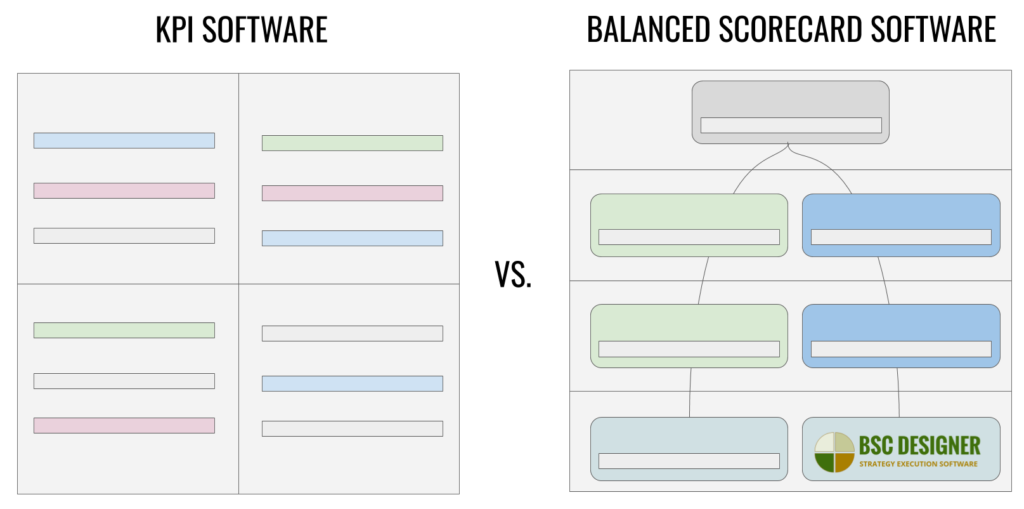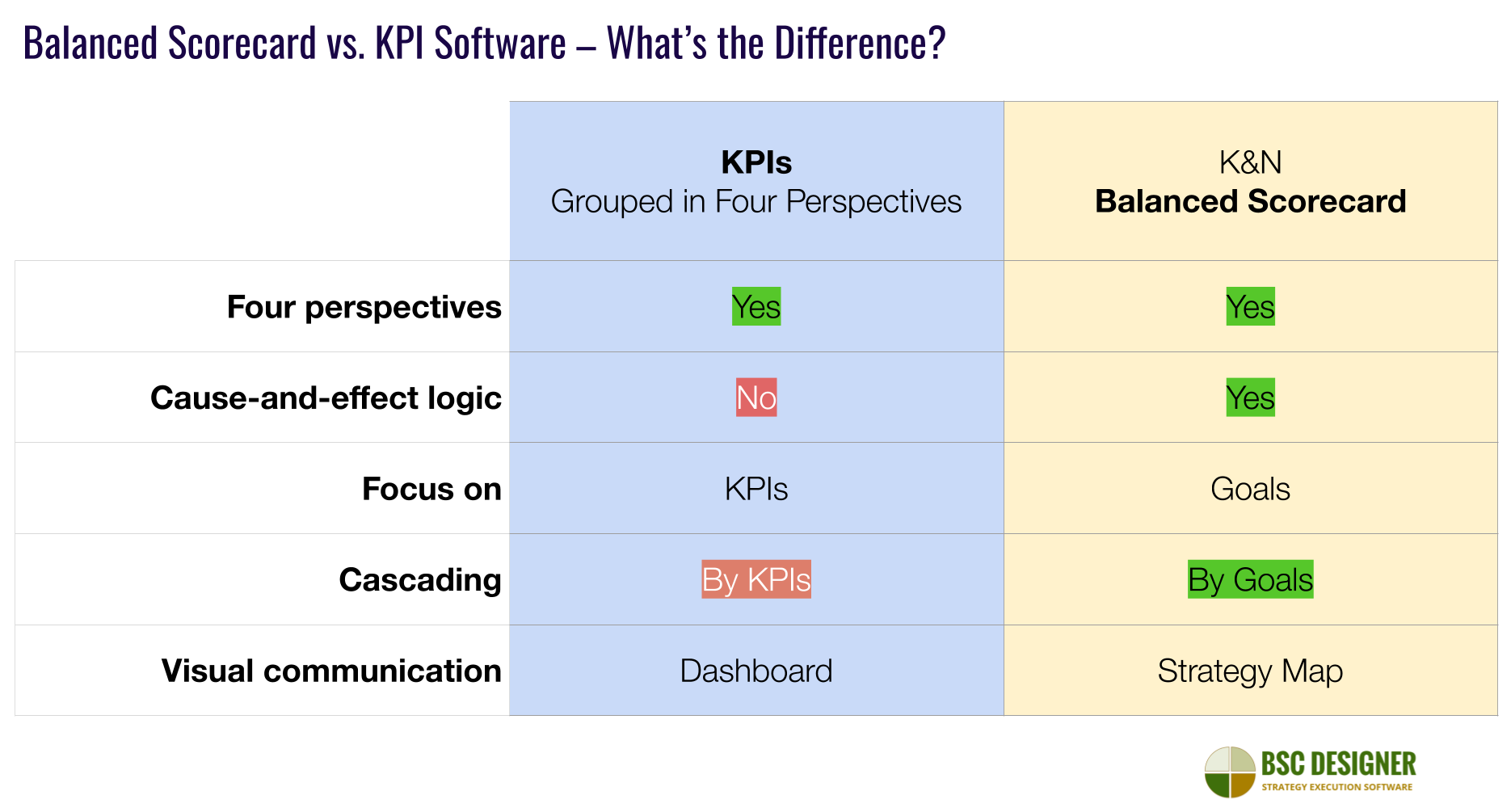This article helps to make it clear what an organization needs now – automation with KPI software or Balanced Scorecard tool.

First Generation Balanced Scorecard is the Root Cause of Confusion
An earlier version of the Balanced Scorecard framework was perceived as a pure measurement tool. The only tangible difference between the Balanced Scorecard and the long list of KPIs was that the Balanced Scorecard suggested sorting the metrics into four perspectives.
Respectively, if you hear that someone needs the Balanced Scorecard, it doesn’t mean people are talking about the latest generation of K&N Balanced Scorecard. In many cases, they mean that they will group their KPIs into the four perspectives.

The Difference Between the K&N Balanced Scorecard and KPIs Grouped into Four Perspectives
The software tools automate certain business frameworks, so before moving ahead and discussing different approaches to automation, let’s clarify the difference in the underlying logic of the concepts used.
| KPIs Grouped in Four Perspectives | K&N Balanced Scorecard | |
| The purpose | Measure business performance from different perspectives | Help to execute strategy by showing the cause-and-effect logic between the goals and making them measurable with performance metrics |
| Four perspectives structure | Yes | Yes |
| Cause-and-effect logic between perspectives | No | Yes |
| Main focus | On KPIs | On business goals |
| Cascading | By KPIs | By business goals |
| Approach to execution | Driven by KPIs. Managers are focused on measurement, business; context comes later | Focus on business context (goals); measurement comes later to make goals more specific and tangible |
| Visual communication tool | Dashboard | Strategy Map |
Let’s discuss shortly the differences and why they matter.
Cause and Effect Logic
A typical KPI scorecard (KPIs grouped into several categories) does not have evidence cause-and-effect logic. Sometimes, it is implied, but normally you won’t see it.
For example:
- As a part of your focus on safety, you might be doing safety awareness training and measuring % of employees trained.
- The focus on safety is supposed to retain talents and lead to higher productivity, measured as production per hour.
How KPI scorecard and Balanced Scorecard approach the same situation:
- On a KPI scorecard, this logic is implied but is not specifically explained.
- On the K&N Balanced Scorecard (on the strategy map), you will see it as a connection between the “Safety awareness goal” and “Retain professionals” goals. Performance metrics will be aligned with them.
Why Focusing on KPIs is a Problem
The next important difference is that KPI Scorecard focuses on performance metrics, while Balanced Scorecard focuses on the business goals.
What’s the problem about focusing on KPIs:
- With the increase in the number of metrics, the implied logic is harder to remember and explain to the team.
- Teams are focused on KPIs, not on achieving important goals. This focus results in motivational and misuse problems. In the best case, we hear “KPIs don’t work for us!”
- The measurement part is more sensitive to the changes of environment. Following the previous example, the goal of “Safety awareness” will stay for a long time, but the specific metrics to track it will come and go.
Why Cascading by KPIs is not a Good Idea
In most cases, cascading by KPIs is a bad idea. The reason is that most KPIs are not divisible into parts.
Let’s take the “safety awareness” metric for example. Safety is supposed to be one of the pillars that go through the whole organization, so let’s see if we can successfully cascade it by the KPI.
- CEO level: safety awareness (copied from HR).
- HR level: safety awareness measured as % of employees who passed respective training.
- Unit level: here we suppose to use something like “% of employees who passed safety training in this business unit,” but it’s tricky as training is controlled by HR and on the unit level, we can only obverse the KPI, not change it.
- Employee level: the metric is supposed to be converted into a binary one. “I’ve passed safety training, yes/no”.
What message did we translate across the organization by cascading in this way? Without wanting it, we basically told our team that:
- Safety is an important thing.
- It’s the job of HR to train us on safety as we don’t have direct control.
- Achieving high numbers for safety KPIs is more important than actual safety improvement.
I’m exaggerating, but that’s how most KPIs are cascaded.
The same cascading done by the goal of “safety awareness” looks more interesting:
- CEO level: achieve high safety awareness across the organization.
- HR level: find the ways to measure safety awareness (some ideas were discussed in strategy awareness article) and improve it.
- Unit level: what safety means in our case, how can we implement these ideas locally?
- Employee level: focus on aspects of safety relevant to my job.
If you want to learn more about the benefits of cascading by goals versus cascading by KPIs, check out the article about cascading mentioned in the beginning.
Why Execution by KPIs Fails
A KPI is a model of a real world, but it is still not a real world.
- KPIs work better when the target domain is stable and predictable. For example, tracking KPIs for a warehouse makes more sense than tracking KPIs for a software company.
- KPIs will make more harm than good if they’re aligned with bonus calculation.
What happens when we focus execution on business goals?
- We will still need metrics, but the business context will come first.
- Following the “business goals first” approach, we can quantify such difficult areas as quality or leadership.
- The KPIs that we will use will follow a certain template.
- Having a business goal in focus, we will first answer the questions “why” and “how”
It looks like these nuances don’t matter much, but in practice, they make a huge difference, especially on a large scale.
How Dashboard is Different from a Strategy Map?
Before, we mentioned that KPI scorecard uses dashboard as a visualization tool, while the K&N Balanced Scorecard is supported by the strategy map.
What’s the difference? We discussed it in detail in a separate article. A quick summary is that a dashboard focuses on the KPIs and their values, while a strategy map is about business goals and the connections between them.
KPI Software vs. Balanced Scorecard Software
We have discussed the differences between the underlying concepts. Now we can answer the question about the difference between the two types of software.
Focus on
- KPI scorecard software focuses its functions on KPIs and scorecard calculation. It’s a good replacement to a prototype of a scorecard created in Excel.
- Balanced Scorecard software is focused on strategy map with a cause-and-effect logic. It’s a good alternative to drawing maps manually or using presentation software.
Cascading
- Balanced Scorecard software is designed with cascading in mind, e.g. goals from one level can be cascaded to the other scorecards.
- A typical KPI software doesn’t offer much in terms of cascading; the KPIs are not the best way to cascade strategy.
Data visualization:
- KPI software is designed with data visualization and analysis in mind, while the features that go under the BI umbrella are normally more developed.
- Similar to KPI software, Balanced Scorecard tools are equipped with various visualization tools. The strategy maps are supported by classical dashboards and performance reports.
Impact on motivation:
- KPI software creates a nice visual picture for top managers but might shift the focus of the team from what matters to what is being counted.
- Balanced Scorecard software creates a picture of a strategy. If not restricted by information silos, it will help to share the common strategy understanding across the organization.
The good news is that most Balanced Scorecard software solutions have some good functionality for KPIs as well as for the K&N Balanced Scorecard.
A Final Word
In this article, I shared my opinion about the use of automation tools. I incline towards using Balanced Scorecard software or focusing on a broader range of strategic planning tools, as they provide more flexibility and align better with the task of executing strategy.
In practice (we see it in the stories that our users shared), the real use cases vary a lot:
- Some used BSC Designer to support a pure KPI scorecard,
- Others build OKRs on it,
- Others used it to support strategy execution following K&N approach.
I hope the ideas from this article will help you to better understand the current needs of your organization and find a tool that matches your needs. And of course, shortlist BSC Designer software as a candidate to automate your Balanced Scorecard.
BSC Designer is strategy execution software that enhances strategy formulation and execution through tangible KPIs. Our proprietary strategy implementation system reflects our practical experience in the strategy domain.